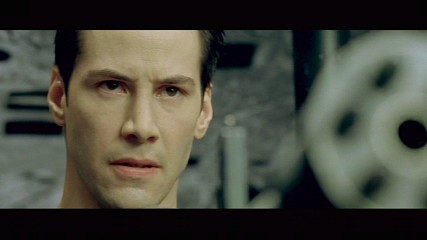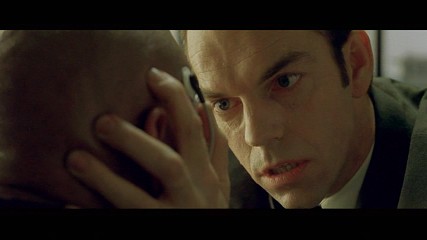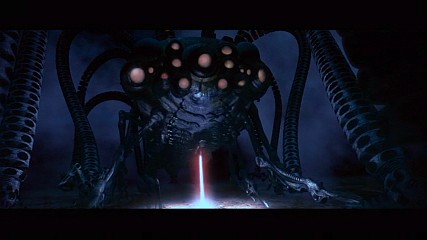|
What is "The Matrix"? Well, for his entire life software engineer/computer hacker Thomas Anderson, AKA Neo, has known that something wasn’t right with the world. Deep down he’s always felt as though he was living a dream he just couldn’t wake up from. During his exploits as a hacker he came across references to something called "The Matrix," and to a man referred only as "Morpheus". So, for the past few years, he’s been tirelessly searching for that man – who also happens to have been looking for Neo. Something Morpheus calls "The One"; a man that can save the world. But from what? Neo learns that the reality he has lived in is merely a facsimile of the 20th century, created by a race of intelligent machines who have enslaved almost the entire human race and have kept their minds occupied in a virtual prison. But before Neo can help Morpheus he must wake up from the dream… and join the real world. The Matrix is an ingenious film containing brilliant choreography, special effects and artistic camera angles, creating a whole new kind of visual style that is both modern and appealing.

Video quality is up to Warner’s usual par with an anamorphic enhanced 2.35:1 widescreen presentation contained on a dual-layered disc. Sharpness levels are outstanding, providing almost endless detail in the remarkable background sets, while chroma noise and grain are both kept to an acceptable minimum. The film is artistically tinted green during scenes inside "The Matrix", and perhaps because of this black levels are not as stable as they could have been. Color during these segments is very muted, although "Real World" scenes are crisp and clear with strong saturation and well-calibrated levels. The entire transfer was taken from an exceptionally clear master print with no dirt or lint visible. The disc contains a total of 38 chapters and 8.3 gigabytes worth of data, with the layer shift occurring at 1:07.41.
The Dolby Digital 5.1 soundtrack is truly exceptional. Every channel is used to full effect, with special emphasis on low frequencies. All dialogue is crystal clear with no extraneous sounds, though during Neo’s initial visit to the Construct what appears to be digital compression noise in the background is audible. Don Davis’s resounding orchestral score comes across with exceptional clarity and a room encompassing sound. English subtitles and closed captioning are also available.

The numerous extra features begin with a commentary audio track starring Carrie-Anne Moss (who plays Trinity), John Gaeta (the visual effects supervisor) and Zach Staenberg (the editor). John Gaeta provides the most interesting material. Another soundtrack option is an isolated music score with verbal notation by the composer, Don Davis. Both are only available in 2.0 audio.
A 25-minute HBO First Looks documentary entitled "The Making of the Matrix" builds up anticipation for the film, but for the real nitty-gritty on the how-and-why you’ll want to check out two other features, "Take the Red Pills" and "Follow the White Rabbit". The first is billed as containing two hidden special effects documentaries scattered throughout the DVD’s menu structure: the 6-minute "What is Bullet Time?", a reel on how the amazing still-motion pans were accomplished, plus the 11-minute "What is the Concept?", a look at production art, special effects clips and paintings, all set to music.

An interesting concept is used in the "Follow the White Rabbit" option. When selected, an icon of a rabbit will pop up at nine special-effects laden periods throughout the film. Pressing "ENTER" on your remote will sweep you off to short reels containing alternate angles and other behind-the-scenes material on the creation of those scenes. You may also directly access these clips by manually selecting a title number between 27 and 35. All of the above feature film clips use full-screen video and 2.0 audio.
Topping off the list of player accessible features are cast & crew biographies and filmographies and full-motion scene selection screens. Several other extras are also included for DVD-equipped PCs. You’ll find hours worth of text: the original screenplay and storyboards, 7 essays and articles on topics ranging from comic books and kung fu to science fiction, plus an archived version of the original theatrical web site. Also available are six theatrical trailers including The Matrix and five other movies based in futuristic worlds such as Max Max, Outland and Demolition Man. All six have been encoded in standard MPEG-1, something that stand-alone DVD players are unable to play.
So, should you own The Matrix? Warner’s fantastic complement of bonus materials coupled with an attractive price of $25 are sure to make this excellent movie a retail mega hit.
- Reviewed by Daniel Tonks on October 13, 1999.

 |  |
| Movie: |
    |
| Video Quality: |
    |
| Audio Quality: |
    |
| Supplements: |
    |
1-Poor 2-Fair 3-Good 4-Excellent
|
System Equipment
Sony DVP-S500D DVD Player
Sony STR-GA8ES 5.1 Receiver
Sony 32" XBR250 WEGA TV using Component
Nuance Spatial & Star Series Speakers
|

| 
